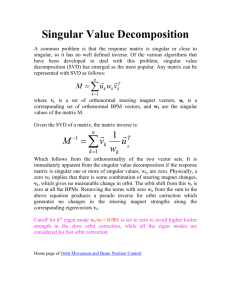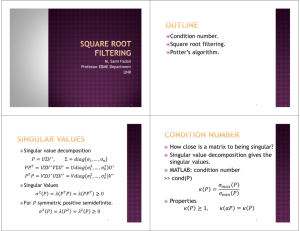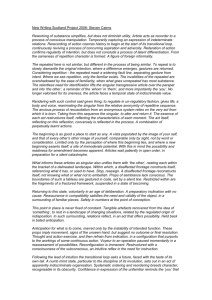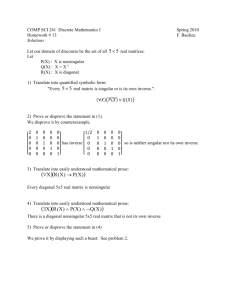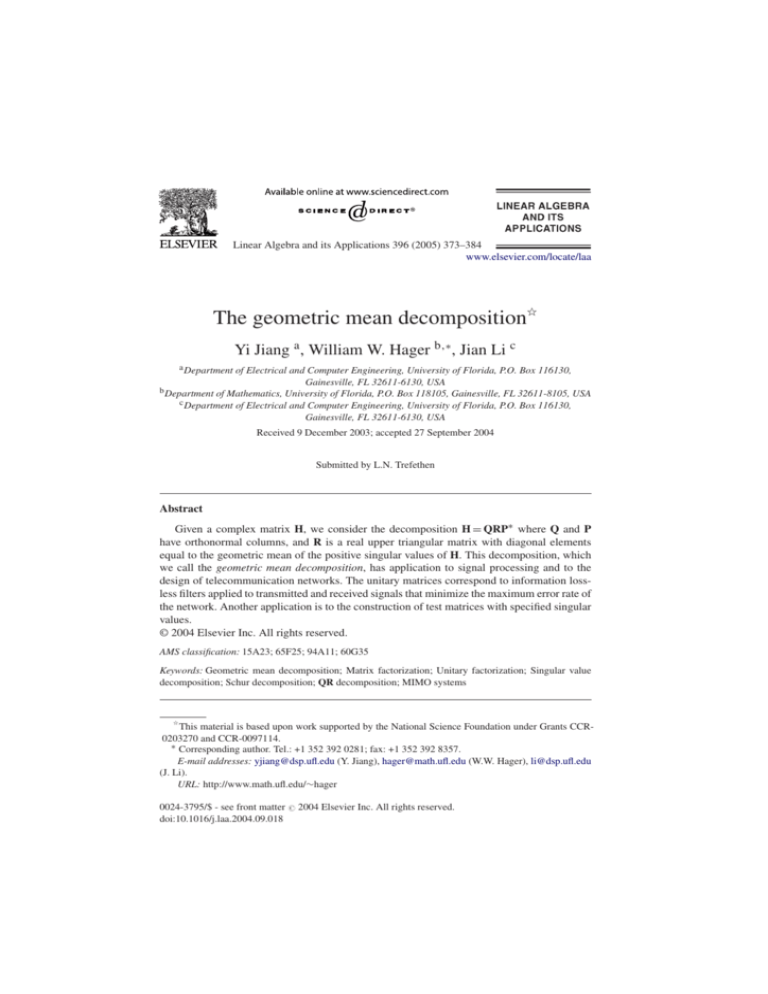
Linear Algebra and its Applications 396 (2005) 373–384
www.elsevier.com/locate/laa
The geometric mean decomposition聻
Yi Jiang a , William W. Hager b,∗ , Jian Li c
a Department of Electrical and Computer Engineering, University of Florida, P.O. Box 116130,
Gainesville, FL 32611-6130, USA
b Department of Mathematics, University of Florida, P.O. Box 118105, Gainesville, FL 32611-8105, USA
c Department of Electrical and Computer Engineering, University of Florida, P.O. Box 116130,
Gainesville, FL 32611-6130, USA
Received 9 December 2003; accepted 27 September 2004
Submitted by L.N. Trefethen
Abstract
Given a complex matrix H, we consider the decomposition H = QRP∗ where Q and P
have orthonormal columns, and R is a real upper triangular matrix with diagonal elements
equal to the geometric mean of the positive singular values of H. This decomposition, which
we call the geometric mean decomposition, has application to signal processing and to the
design of telecommunication networks. The unitary matrices correspond to information lossless filters applied to transmitted and received signals that minimize the maximum error rate of
the network. Another application is to the construction of test matrices with specified singular
values.
© 2004 Elsevier Inc. All rights reserved.
AMS classification: 15A23; 65F25; 94A11; 60G35
Keywords: Geometric mean decomposition; Matrix factorization; Unitary factorization; Singular value
decomposition; Schur decomposition; QR decomposition; MIMO systems
聻
This material is based upon work supported by the National Science Foundation under Grants CCR0203270 and CCR-0097114.
∗ Corresponding author. Tel.: +1 352 392 0281; fax: +1 352 392 8357.
E-mail addresses: yjiang@dsp.ufl.edu (Y. Jiang), hager@math.ufl.edu (W.W. Hager), li@dsp.ufl.edu
(J. Li).
URL: http://www.math.ufl.edu/∼hager
0024-3795/$ - see front matter 2004 Elsevier Inc. All rights reserved.
doi:10.1016/j.laa.2004.09.018
374
Y. Jiang et al. / Linear Algebra and its Applications 396 (2005) 373–384
1. Introduction
It is well known that any square matrix has a Schur decomposition QUQ∗ , where
U is upper triangular with eigenvalues on the diagonal, Q is unitary, and * denotes
conjugate transpose. In addition, any matrix has a singular value decomposition
(SVD) VW∗ where V and W are unitary, and is completely zero except for
the singular values on the diagonal of . In this paper, we focus on another unitary
decomposition which we call the geometric mean decomposition or GMD. Given
a rank K matrix H ∈ Cm×n , we write it as a product QRP∗ where P and Q have
orthonormal columns, and R ∈ RK×K is a real upper triangular matrix with diagonal
elements all equal to the geometric mean of the positive singular values:
1/K
σj
, 1 i K.
rii = σ̄ =
σj >0
Here the σj are the singular values of H, and σ̄ is the geometric mean of the positive
singular values. Thus R is upper triangular and the nonzero diagonal elements are
the geometric mean of the positive singular values.
As explained below, we were led to this decomposition when trying to optimize
the performance of multiple-input multiple-output (MIMO) systems. However, this
decomposition has arisen recently in several other applications. In [7–Prob. 26.3]
Higham proposed the following problem:
Develop an efficient algorithm for computing a unit upper triangular matrix with
prescribed singular values σi , 1 i K, where the product of the σi is 1.
A solution to this problem could be used to construct test matrices with user specified
singular values.
The solution of Kosowski and Smoktunowicz [10] starts with the diagonal matrix
, with ith diagonal element σi , and applies a series of 2 × 2 orthogonal transformations to obtain a unit triangular matrix. The complexity of their algorithm is O(K 2 ).
Thus the solution given in [10] amounts to the statement
QT0 P0 = R,
(1)
where R is unit upper triangular.
For general , where the product of the σi is not necessarily 1, one can multiply
by the scaling factor σ̄ −1 , apply (1), then multiply by σ̄ to obtain the GMD of .
And for a general matrix H, the singular value decomposition H = VW∗ and (1)
combine to give the H = QRP∗ where
Q = VQ0
and
P = WP0 .
In a completely different application, [17] considers a signal processing problem:
design “precoders for suppressing the intersymbol interference (ISI).” An optimal
precoder corresponds to a matrix F that solves the problem
Y. Jiang et al. / Linear Algebra and its Applications 396 (2005) 373–384
max min
F
375
{uii : 1 i K}
(2)
subject to QU = HF, tr(F∗ F) p,
where tr denotes the trace of a matrix, p is a given positive scalar called the power
constraint, and QU denotes the factorization of HF into the product of a matrix with
orthonormal columns and an upper triangular matrix with nonnegative diagonal (the
QR factorization). Thus, the goal is to find a matrix F that complies with the power
constraint, and which has the property that the smallest diagonal element of U is as
large as possible. The authors show that if F is a multiple of a unitary matrix and the
diagonal elements of U are all equal, then F attains the minimum in (2). Hence, a
solution of (2) is
p
p
F=P
and U = R
,
K
K
where H = QRP∗ is the GMD. In [17] an O(K 4 ) algorithm is stated, without proof,
for computing an equal diagonal R.
Our own interest in the GMD arose in signal processing in the presence of noise.
Possibly, in the next generation of wireless technology, each transmission antenna
will be replaced by a cluster of antennas, vastly increasing the amount of data that
can be transmitted. The communication network, which can be viewed as a multipleinput multiple-output (MIMO) system, supports significantly higher data rates and
offers higher reliability than single-input single-output (SISO) systems [2,12,13].
A MIMO system can be modeled in the following way:
y = Hx + z,
(3)
where x ∈ C is the transmitted data, y ∈ C is the received data, z ∈ C is the
noise, and H is the channel matrix. Suppose H is decomposed as H = QRP∗ , where
R is a K × K upper triangular matrix, and P and Q are matrices with orthonormal
columns that correspond to filters on the transmitted and received signals. With this
substitution for H in (3), we obtain the equivalent system
n
m
m
ỹ = Rs + z̃,
(4)
Q∗ y,
Q∗ z.
with precoding x = Ps, with decoding ỹ =
and with noise z̃ =
Although the interference with the transmitted signal is known by the transmitter, the off-diagonal elements of R will inevitably result in interference with the
desirable signal at the receiver. However, Costa predicted in [1] the amazing fact
that the interference known at the transmitter can be cancelled completely without
consuming additional input power. As a realization of Costa’s prediction, in [3] the
authors applied the so-called Tomlinson–Harashima precodes to convert (4) into K
decoupled parallel subchannels:
ỹi = rii si + z̃i ,
i = 1, . . . , K.
Assuming the variance of the noise on the K subchannels is the same, the subchannel
with the smallest rii has the highest error rate. This leads us to consider the problem
of choosing Q and P to maximize the minimum of the rii :
376
Y. Jiang et al. / Linear Algebra and its Applications 396 (2005) 373–384
max min
{rii : 1 i K}
subject to
QRP∗ = H, Q∗ Q = I, P∗ P = I,
Q,P
rij = 0 for i > j, R ∈ R
K×K
(5)
,
where K is the rank of H. If we take p = K in (2), then any matrix that is feasible
in (5) will be feasible in (2). Since the solution of (2) is given by the GMD of H
when p = K, and since the GMD of H is feasible in (5), we conclude that the GMD
yields the optimal solution to (5). In [9] we show that a transceiver designed using
the GMD can achieve asymptotically optimal capacity and excellent bit error rate
performance.
An outline of the paper is as follows: In Section 2, we strengthen the maximin
property of the GMD by showing that it achieves the optimal solution of a less constrained problem where the orthogonality constraints are replaced by less stringent
trace constraints. Section 3 gives an algorithm for computing the GMD of a matrix,
starting from the SVD. Our algorithm, like that in [10], involves permutations and
multiplications by 2 × 2 orthogonal matrices. Unlike the algorithm in [10], we use
Givens rotations rather than orthogonal factors gotten from the SVD of 2 × 2 matrices. And the permutations in our algorithm are done as the algorithm progresses
rather than in a preprocessing phase. One advantage of our algorithm is that we are
able to use it in [8] to construct a factorization H = QRP∗ , where the diagonal of R
is any vector satisfying Weyl’s multiplicative majorization conditions [15]. Section 4
shows how the GMD can be computed directly, without first evaluating the SVD, by
a process that combines Lanczos’ method with Householder matrices. This version
of the algorithm would be useful if the matrix is encoded in a subroutine that returns
the product of H with a vector. In Section 5 we examine the set of 3 × 3 matrices for
which a bidiagonal R is possible.
2. Generalized maximin properties
Given a rank K matrix H ∈ Cm×n , we consider the following problem:
max min
{|uii | : 1 i K}
subject to
U = G∗ HF, uij = 0 for i > j, U ∈ CK×K ,
F,G
tr(G∗ G)
p1 ,
tr(F∗ F)
(6)
p2 .
Again, tr denotes the trace of a matrix. If p1 = p2 = K, then each Q and P feasible
in (5) is feasible in (6). Hence, problem (6) is less constrained than problem (5) since
the set of feasible matrices has been enlarged by the removal of the orthogonality
constraints. Nonetheless, we now show that the solution to this relaxed problem is
the same as the solution of the more constrained problem (5).
Y. Jiang et al. / Linear Algebra and its Applications 396 (2005) 373–384
377
Theorem 1. If H ∈ Cm×n has rank K, then a solution of (6) is given by
√
p1 p2
p1
p2
, U=
R, and F = P
,
G=Q
K
K
K
where QRP∗ is the GMD of H.
Proof. Let F and G satisfy the constraints of (6). Let Ḡ be the matrix obtained by
replacing each column of G by its projection into the column space of H. Let F̄ be
the matrix obtained by replacing each column of F by its projection into the column
space of H∗ . Since the columns of G − Ḡ are orthogonal to the columns of Ḡ, we
have
G∗ G = (G − Ḡ)∗ (G − Ḡ) + Ḡ∗ Ḡ.
Since the diagonal of a matrix of the form M∗ M is nonnegative and since tr(G∗ G) p1 , we conclude that
tr(Ḡ∗ Ḡ) p1 .
By similar reasoning,
tr(F̄∗ F̄) p2 .
Since the columns of G − Ḡ are orthogonal to the columns of H and since the columns of F − F̄ are orthogonal to the columns of H∗ , we have (G − Ḡ)∗ H = 0 =
H(F − F̄); it follows that
U = G∗ HF = Ḡ∗ HF̄.
In summary, given any G, F, and U that are feasible in (6), there exist Ḡ and F̄ such
that Ḡ, F̄, and U are feasible in (6), the columns of Ḡ are contained in the column
space of H, and the columns of F̄ are contained in the column space of H∗ .
We now prove that
√
σ̄ p1 p2
,
min |uii | 1i K
K
whenever U is feasible in (6). By the analysis given above, there exist G and F associated with the feasible U in (6) with the columns of G and F contained in the column
spaces of H and H∗ respectively. Let VW∗ be the singular value decomposition of
H, where ∈ RK×K contains the K positive singular values of H on the diagonal.
Since the column space of V coincides with the column space of H, there exists a
square matrix A such that G = VA. Since the column space of W coincides with the
column space of H∗ , there exists a square matrix B such that F = WB. Hence, we
have
U = G∗ HF = (VA)∗ H(WB)
= (VA)∗ VW∗ (WB) = A∗ B.
378
Y. Jiang et al. / Linear Algebra and its Applications 396 (2005) 373–384
It follows that
min |uii |2K 1i K
K
|uii |2 = det(U∗ U)
i=1
= det(∗ )det(A∗ A)det(B∗ B)
= det(∗ )det(G∗ G)det(F∗ F)
= σ̄ 2K det(G∗ G)det(F∗ F),
(7)
where det denotes the determinant of a matrix. By the geometric mean inequality
and the fact that the determinant (trace) of a matrix is the product (sum) of the eigenvalues,
K ∗
K
det(G∗ G) tr(GK G)
pK1
and
∗ K K
p
tr
(F
F)
det(F∗ F) K2 .
K
Combining this with (7) gives
√
σ̄ p1 p2
.
min |uii | 1i K
K
(8)
Finally, it can be verified that the choices for G, U, and F given in the statement of
the theorem satisfy the constraints of (6) and the inequality (8) is an equality. 3. Implementation based on SVD
In this section, we prove the following theorem by providing a constructive algorithm for computing the GMD:
Theorem 2. If H ∈ Cm×n has rank K, then there exist matrices P ∈ Cn×K and Q ∈
Cm×K with orthonormal columns, and an upper triangular matrix R ∈ RK×K such
that H = QRP∗ , where the diagonal elements of R are all equal to the geometric
mean of the positive singular values.
Our algorithm for evaluating the GMD starts with the singular value decomposition H = VW∗ , and generates a sequence of upper triangular matrices R(L) , 1 L < K, with R(1) = . Each matrix R(L) has the following properties:
(L)
(a) rij = 0 when i > j or j > max{L, i},
(L)
(L)
(b) rii = σ̄ for all i < L, and the geometric mean of rii , L i K, is σ̄ .
We express R(k+1) = QTk R(k) Pk where Qk and Pk are orthogonal for each k.
Y. Jiang et al. / Linear Algebra and its Applications 396 (2005) 373–384
379
These orthogonal matrices are constructed using a symmetric permutation and a
(k)
pair of Givens rotations. Suppose that R(k) satisfies (a) and (b). If rkk σ̄ , then let be a permutation matrix with the property that R(k) exchanges the (k + 1)st diag(k)
onal element of R(k) with any element rpp , p > k, for which rpp σ̄ . If rkk < σ̄ ,
then let be chosen to exchange the (k + 1)st diagonal element with any element
(k)
(k)
rpp , p > k, for which rpp σ̄ . Let δ1 = rkk and δ2 = rpp denote the new diagonal
elements at locations k and k + 1 associated with the permuted matrix R(k) .
Next, we construct orthogonal matrices G1 and G2 by modifying the elements
in the identity matrix that lie at the intersection of rows k and k + 1 and columns k
and k + 1. We multiply the permuted matrix R(k) on the left by GT2 and on the
right by G1 . These multiplications will change the elements in the 2 × 2 submatrix
at the intersection of rows k and k + 1 with columns k and k + 1. Our choice for
the elements of G1 and G2 is shown below, where we focus on the relevant 2 × 2
submatrices of GT2 , R(k) , and G1 :
cδ1 sδ2
δ1 0
c −s
σ̄ x
σ̄ −1
=
.
−sδ2 cδ1
0 δ2
s
c
0 y
(9)
(R(k) )
(G1 )
(R(k+1) )
(GT2 )
If δ1 = δ2 = σ̄ , we take c = 1 and s = 0; if δ1 =
/ δ2 , we take
σ̄ 2 − δ22
c=
and
s
=
1 − c2 .
δ12 − δ22
(10)
In either case,
x=
sc(δ22 − δ12 )
σ̄
and
y=
δ 1 δ2
.
σ̄
(11)
Since σ̄ lies between δ1 and δ2 , s and c are nonnegative real scalars.
Fig. 1 depicts the transformation from R(k) to GT2 R(k) G1 . The dashed box is
the 2 × 2 submatrix displayed in (9). Notice that c and s, defined in (10), are real
scalars chosen so that
c2 + s 2 = 1
and
(cδ1 )2 + (sδ2 )2 = σ̄ 2 .
With these identities, the validity of (9) follows by direct computation. Defining
Qk = G2 and Pk = G1 , we set
R(k+1) = QTk R(k) Pk .
(12)
It follows from Fig. 1, (9), and the identity det(R(k+1) ) = det(R(k) ), that (a) and (b)
hold for L = k + 1. Thus there exists a real upper triangular matrix R(K) , with σ̄ on
the diagonal, and unitary matrices Qi and Pi , i = 1, 2, . . . , K − 1, such that
R(K) = (QTk−1 · · · QT2 QT1 )(P1 P2 · · · Pk−1 ).
380
Y. Jiang et al. / Linear Algebra and its Applications 396 (2005) 373–384
Column k
X X X
0
0
0
X X X X 0
0
X X 0
0
0
X X X 0
0
X 0
0
0
X X 0
0
X 0
0
X 0
0
Row k
X 0
X 0
X
X
(k)
R
( k)
G* Π R
2
Π G1
Fig. 1. The operation displayed in (9).
Combining this identity with the singular value decomposition, we obtain H =
QRP∗ where
K−1 K−1 (K)
Q=V
Qi , R = R , and P = W
Pi .
i=1
i=1
In summary, our algorithm for computing the GMD, based on an initial SVD, is
the following:
(1) Let H = VW∗ be the singular value decomposition of H, and initialize Q = V,
P = W, R = , and k = 1,
(2) If rkk σ̄ , choose p > k such that rpp σ̄ . If rkk < σ̄ , choose p > k such that
rpp σ̄ . In R, P, and Q, perform the following exchanges:
rk+1,k+1 ↔ rpp ,
P:,k+1 ↔ P:,p ,
Q:,k ↔ Q:,p ,
(3) Construct the matrices G1 and G2 shown in (9). Replace R by GT2 RG1 , replace
Q by QG2 , and replace P by PG1 ,
(4) If k = K − 1, then stop, QRP∗ is the GMD of H. Otherwise, replace k × k + 1
and go to step 2.
A Matlab implementation of this algorithm for the GMD is posted at the following
web site:
http://www.math.ufl.edu/ ∼ hager/papers/gmd.m
Given the SVD, this algorithm for the GMD requires O((m + n)K) flops. For
comparison, reduction of H to bidiagonal form by the Golub–Kahan bidiagonalization scheme [4] (also see [5,6,14,16]), often the first step in the computation of the
SVD, requires O(mnK) flops.
Y. Jiang et al. / Linear Algebra and its Applications 396 (2005) 373–384
381
4. The unitary update
In Section 3, we construct the successive columns of the upper triangular matrix
R in the GMD by applying a unitary transformation. We now give a different view
of this unitary update. This new view leads to a direct algorithm for computing the
GMD, without having to compute the SVD.
Since any matrix can be unitarily reduced to a real matrix (for example, by using
the Golub–Kahan bidiagonalization [4]), we assume, without loss of generality, that
H is real. The first step in the unitary update is to generate a unit vector p such that
Hp = σ̄ , where the norm is the Euclidean norm. Such a vector must exist for the
following reason: If v1 and v2 are right singular vectors of unit length associated
with the largest and smallest singular values of H respectively, then
Hv1 σ̄ Hv2 ,
(13)
that is, the geometric mean of the singular values lies between the largest and the
smallest singular value. Let v(θ) be the vector obtained by rotating v1 through an
angle θ toward v2 . Since v1 is perpendicular to v2 , we have v(0) = v1 and v(π/2) =
v2 . Since v(θ) is a continuous function of θ and (13) holds, there exists θ̄ ∈ [0, π/2]
such that Hv(θ̄) = σ̄ . We take p = v(θ̄ ), which is a unit vector since a rotation
does not change length.
Note that we do not need to compute extreme singular vectors, we only need to
find approximations satisfying (13). Such approximations can be generated by an
iterative process such as Lanczos’ method (see [11–Chapter 13]). Let P1 and Q1 be
orthogonal matrices with first columns p and Hp/σ̄ respectively. These orthogonal
matrices, which must exist since p and Hp/σ̄ are unit vectors, can be expressed in
terms of Householder reflections [6–p. 210]. By the design of P1 and Q1 , we have
σ̄ z2
,
QT1 H1 P1 =
0 H2
where H1 = H, z2 ∈ Rn−1 , and H2 ∈ R(m−1)×(n−1) .
The reduction to triangular form continues in this way; after k − 1 steps, we have
T
k−1
k−1
Rk Zk
,
(14)
Qj
Pj =
0
Hk
j =1
j =1
where Rk is a k × k upper triangular matrix with σ̄ on the diagonal, the Qj and Pj
are orthogonal, 0 denotes a matrix whose entries are all 0, and the geometric mean
of the singular values of Hk is σ̄ . In the next step, we take
Ik 0
Ik 0
Pk =
and Qk =
,
(15)
0 P̄
0 Q̄
where Ik is a k × k identity matrix. The first column p̄ of P̄ is chosen so that Hk p̄ =
σ̄ , while the first column of Q̄ is Hk p̄/σ̄ .
382
Y. Jiang et al. / Linear Algebra and its Applications 396 (2005) 373–384
This algorithm generates the GMD directly from H, without first computing the
SVD. In the case that H is , the algorithm of Section 3 corresponds to a vector p
in this section that is entirely zero except for two elements containing c and s. Note
that the value of σ̄ could be computed from an LU factorization (for example, see
[14–Theorem 5.6]).
5. Bidiagonal GMD?
From dimensional analysis, one could argue that a bidiagonal R is possible. The
K singular values of a rank K matrix represent K degrees of freedom. Likewise, a
K × K bidiagonal matrix with constant diagonal has K degrees of freedom, the diagonal element and the K − 1 superdiagonal elements. Nonetheless, we now observe
that a bidiagonal R is not possible for all choices H.
Let us consider the collection of 3 × 3 diagonal matrices with diagonal elements σ1 , σ2 , and σ3 normalized so that
σ1 σ2 σ3 = 1.
(16)
In this case, σ̄ = 1. Suppose that
= QBP∗ ,
where B is an upper bidiagonal matrix with σ̄ = 1 on the diagonal. Since the singular
values of and B coincide, there exist values a and b for the superdiagonal elements
b12 and b23 for which the singular values of B are σ1 , σ2 , and σ3 .
Fig. 2. Projection of feasible singular values onto a 4 × 4 square oriented perpendicular to (1,1,1).
Y. Jiang et al. / Linear Algebra and its Applications 396 (2005) 373–384
383
Fig. 3. Projection of feasible singular values onto a 100 × 100 square oriented perpendicular to (1,1,1).
Figs. 2 and 3 are generated in the following way: For each pair (a, b), we compute the singular values σ1 , σ2 , and σ3 of B, and we project the computed 3-tuple
(σ1 , σ2 , σ3 ) onto the plane through the origin that is perpendicular to the vector (1, 1,
1). A dot is placed on the plane at the location of the projected point; as an increasing
number of pairs (a, b) is considered, the dots form a shaded region associated with
the singular values for which a bidiagonal GMD can be achieved. The white region
corresponds to singular values for which a bidiagonal R is impossible.
Figs. 2 and 3 show the shaded regions associated with 4 × 4 and 100 × 100
squares centered at the origin in the plane perpendicular to (1,1,1). The origin of
either square corresponds to the singular values σ1 = σ2 = σ3 = 1. Fig. 2 is a speck
at the center of Fig. 3. These figures indicate that for well-conditioned matrices, with
singular values near σ1 = σ2 = σ3 = 1, a bidiagonal GMD is not possible, in most
cases. As the matrix becomes more ill-conditioned (see Fig. 3), the relative size of
the shaded region, associated with a bidiagonal GMD, increases relative to the white
region, where a bidiagonal GMD is impossible.
6. Conclusions
The geometric mean decomposition H = QRP∗ , where the columns of Q and P
are orthonormal and R is a real upper triangular matrix with diagonal elements all
384
Y. Jiang et al. / Linear Algebra and its Applications 396 (2005) 373–384
equal to the geometric mean of the positive singular values of H, yields a solution to
the maximin problem (6); the smallest diagonal element of R is as large as possible.
In MIMO systems, this minimizes the worst possible error in the transmission process. Other applications of the GMD are to precoders for suppressing intersymbol
interference, and to the generation of test matrices with prescribed singular values.
Starting with the SVD, we show in Section 3 that the GMD can be computed using a
series of Givens rotations, and row and column exchanges. Alternatively, the GMD
could be computed directly, without performing an initial SVD, using a Lanczos
process and Householder matrices. In a further extension of our algorithm for the
GMD, we show in [8] how to compute a factorization H = QRP∗ where the diagonal
of R is any vector satisfying Weyl’s multiplicative majorization conditions [15].
References
[1] M. Costa, Writing on dirty paper, IEEE Trans. Inf. Theory 29 (1983) 439–441.
[2] G.J. Foschini, M.J. Gans, On limits of wireless communications in a fading environment when using
multiple antennas, Wireless Person. Commun. 6 (1998) 311–335.
[3] G. Ginis, J.M. Cioffi, Vectored transmission for digital subscriber line systems,IEEE J. Select. Areas
Commun. 20 (2002) 1085–1104.
[4] G.H. Golub, W. Kahan, Calculating the singular values and pseudo-inverse of a matrix, SIAM J.
Numer. Anal. 2 (1965) 205–224.
[5] G.H. Golub, C.F. Van Loan, Matrix Computations, Johns Hopkins University Press, Baltimore, MD,
1996.
[6] W.W. Hager, Applied Numerical Linear Algebra, Prentice-Hall, Englewood Cliffs, NJ, 1988.
[7] N.J. Higham, Accuracy and Stability of Numerical Algorithms, SIAM, Philadelphia, 1996.
[8] Y. Jiang, W.W. Hager, J. Li, The generalized triangular decomposition, SIAM J. Matrix Anal. Appl.,
submitted for publication.
[9] Y. Jiang, J. Li, W.W. Hager, Joint transceiver design for MIMO systems using geometric mean
decomposition, IEEE Trans. Signal Process., accepted for publication.
[10] P. Kosowski, A. Smoktunowicz, On constructing unit triangular matrices with prescribed singular
values, Computing 64 (2000) 279–285.
[11] B.N. Parlett, The Symmetric Eigenvalue Problem, Prentice-Hall, Englewood Cliffs, NJ, 1980.
[12] G.G. Raleigh, J.M. Cioffi, Spatial–temporal coding for wireless communication, IEEE Trans. Commun. 46 (1998) 357–366.
[13] I.E. Telatar, Capacity of multi-antenna Gaussian channels, European Trans. Telecommun. 10 (1999)
585–595.
[14] L.N. Trefethen, D. Bau III, Numerical Linear Algebra, SIAM, Philadelphia, 1997.
[15] H. Weyl, Inequalities between two kinds of eigenvalues of a linear transformation, Proc. Nat. Acad.
Sci. USA 35 (1949) 408–411.
[16] J.H. Wilkinson, C. Reinsch, Linear algebra, in: F.L. Bauer (Ed.), Handbook for Automatic Computation, vol. 2, Springer-Verlag, Berlin, 1971.
[17] J.-K. Zhang, A. Kavčić, X. Ma, K.M. Wong, Design of unitary precoders for ISI channels, in: Proceedings IEEE International Conference on Acoustics Speech and Signal Processing, vol. 3, IEEE,
Orlando, FL, 2002, pp. 2265–2268 .

